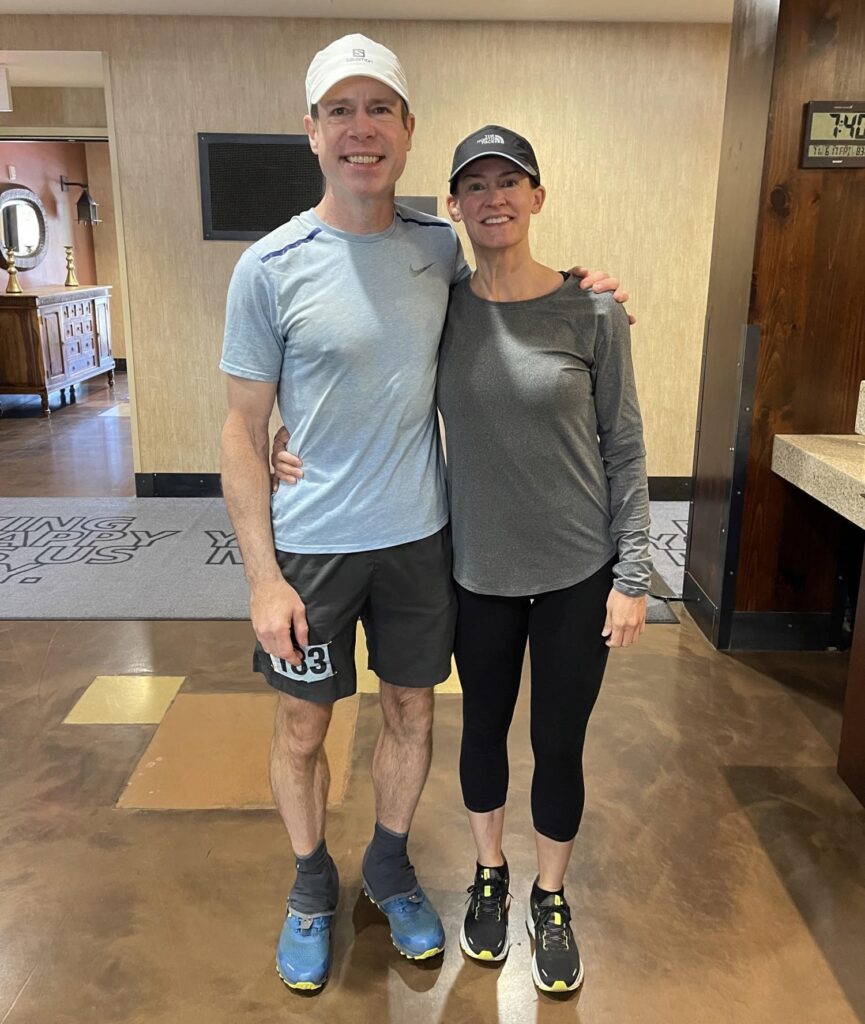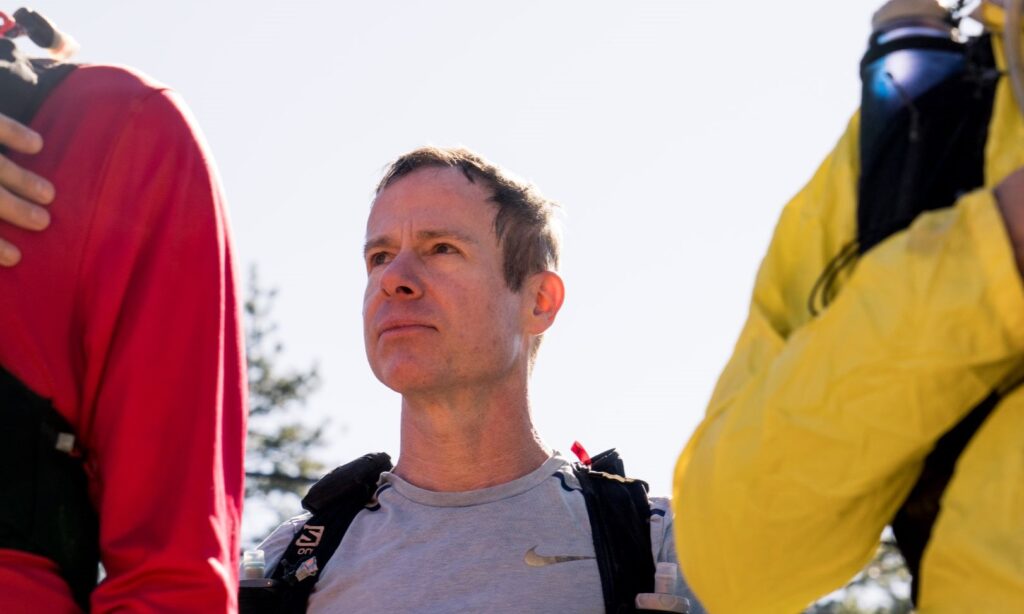
What Not to do Before a 200-Mile Race
It was Thursday night, 9 PM. Exactly twelve hours before the start of the Tahoe 200. This would be my twelfth 200-mile race, and my fourth time running the Tahoe 200. I was in bed at a hotel near the starting line. I set down the novel I’d been reading. It was a physical book. Unlike reading from a screen, which tends to keep the mind alert and awake, reading from an actual book would allow my mind to relax and ready itself for sleep. I turned on the white noise machine I’d brought from home. It drowned out incidental distractions from outside and from neighboring rooms, and created a pleasant, steady sound similar to a burbling stream. Then I lay down on my side, my left shoulder supported by a fluffy blanket that reduced the pressure from the mattress, minimizing the need to roll to my other side partway through the night. I’d stopped drinking fluids earlier in the night to reduce the likelihood of needing to get up to use the bathroom. I’d practiced all of these actions in the months leading up to the race. In the past I’d had difficulty falling asleep the night before a big race, but it was going to be different this time.
I glanced at the clock. It was 9:15 PM. I closed my eyes and sleep arrived within the first couple minutes. When my eyes next opened, I realized how quickly I’d fallen asleep and was satisfied with how the night was starting. Granted, I wasn’t particularly happy I’d woken up so soon, but it was 10:15 PM and I’d already slept for an hour. I had already exceeded the amount of sleep I’d gotten before the Tahoe 200 back in 2019. I closed my eyes.
I would not fall asleep again for the rest of the night. I would roll from one side to the other. I would use the restroom a number of times. I would think about nothing, or I would think about random things or I would think about the race. All I wanted to do was sleep.
I would start the race after having a total of one hour of sleep in the preceding 28 hours. To hit my goal of finishing in less than 60 hours meant I would need to go 88 hours without sleep while covering 200 miles of mountainous terrain. This wasn’t possible.
The Early Hours. Mile 0 to 30.
229 of us stood at the starting line that morning. I felt fresh and strong. Awake. Alert. There was a countdown from ten, and then the horn blew. I started at an easy pace, jogging only a handful of steps before switching to a steady, fast-paced hike up the ski slope toward the Tahoe Rim Trail. Other runners were around me, most of whom were taking a similar approach. The leader, who I didn’t recognize, was an exception. He took off aggressively, running up the slope at a good clip. Mike Groenewegen followed the leader in close pursuit. I knew Mike from the previous year’s Bigfoot 200 and Moab 240. He and I had spent some time running together during portions of both of those races. Mike had started Bigfoot and Moab in the lead pack, but then dropped back to finish 9th at Bigfoot and 33rd at Moab. Those were strong finishes, but, now that he had some 200-mile experience under his belt, it was clear he was planning something greater for Tahoe.
This year’s course had been altered due to reconstruction work occurring on the south side of Lake Tahoe where the Caldor fire had wrought havoc in 2021. As a result, the normal, single-loop course had been changed to an out-and-back route along what was ordinarily the second half of the loop.
After ascending the ski slope, we dropped down to what would have been the Barker Pass aid station had we been following the typical route, but was merely an empty spot on the dirt road this year. Then came the steep, somewhat technical descent to Stephen Jones aid station.
Mentally, the lack of sleep already weighed on me like a sandbag. I didn’t dwell on the issue across long periods of time, but it kept recurring as a brief thought that distracted me when I might otherwise be focused on the moment I was experiencing, unconsciously selecting my next footfall on a technical portion of trail, or accelerating on smooth single-track. Instead, my thoughts would flicker to the impact the lack of sleep was going to have on my ability to push as hard as I needed to. My thoughts would turn to the fact that, instead of taking three or four 10-minute dirt naps along the course, I would need to sleep for a longer period of time…three hours? Four hours? At times when I should have been moving forward, I would instead be asleep.
At one point during that first section from the start line to Stephen Jones aid station, I even began mentally calculating the impact the extra hours spent sleeping during the race would have on my finishing time. It was a self-defeating line of thought, but for some reason I couldn’t help it. It was as if the part of my brain that retained my memories and lessons from past races had been silenced by the part of my brain that focused solely on fear and survival. So, instead of seeking a path through the obstacles confronting me, I was focused on the obstacles themselves and the harm they were going to do to me and my results.
The weather was cool, hovering in the mid-forties even during the heat of the day. It was perfect running weather. I kept on top of my nutrition and fluid plans, sipping electrolytes with disciplined regularity every few minutes and eating solid food two or three times per hour. I made it through the first aid station at mile 10.4 in three minutes, just under plan. By all measures, it was a good start to the race.
Physically, I didn’t feel any effects from the lack of sleep throughout the first day. I stayed with the other front runners, varying between 4th and 7th place from one section of trail to another as a few of us morphed between running as a group and running solo.
From the Stephen Jones aid station, the course followed a seldom-used, wooded and marshy trail down to a cement sidewalk that paralleled the shore of Lake Tahoe. Three miles later, the single-track ascent up to Stanford Rock began. The section ended with a pleasant descent to Tahoe City. Pleasant, that is, aside from the maze-like section of trail where an ill-intentioned hiker or mischievous punk had decided to pull down most of the course markings. Soon enough I was moving along the path beside the Truckee River and the aid station came into view.
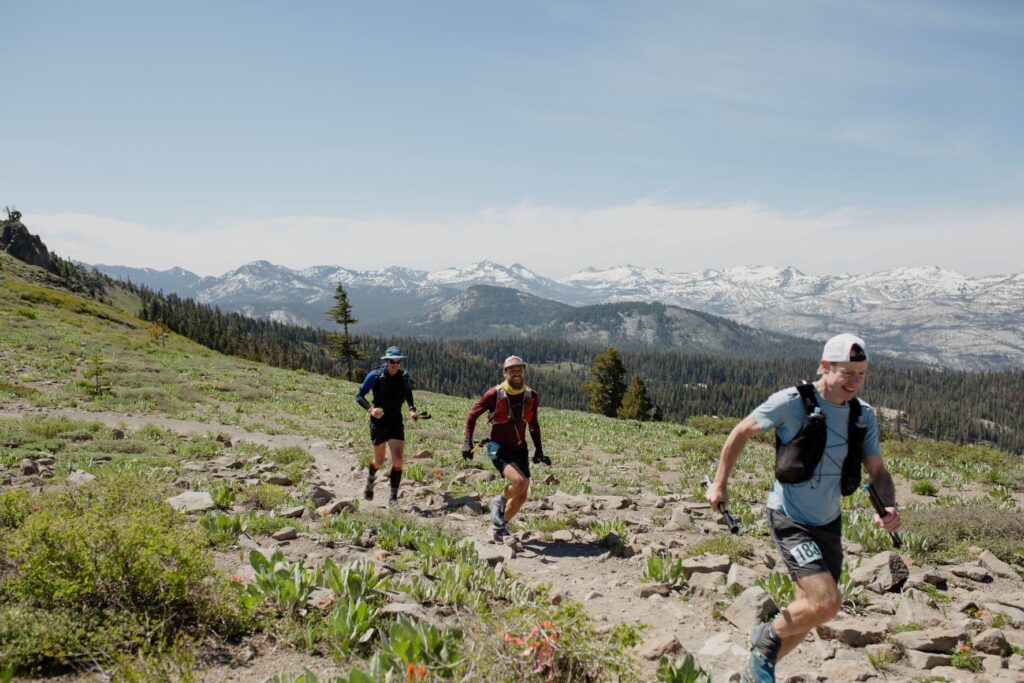
Missing the Signs. Mile 30 to 50.
I linked up with Heather, my girlfriend and sole crew member, at the Tahoe City aid station. With 30 miles and 5500 feet of cumulative vertical ascent on my legs I was still feeling strong. For the last few miles, I’d been experiencing mild pressure from my shoe on the lowest joint of my left big toe. That issue, along with the fact that my shoes were still damp from the marsh water, made me decide to make an early change of shoes and socks to prevent this minor nuisance from developing into a real problem. Heather was prepared for this possibility, and had a pair of alternate shoes and socks ready for me. I was able to complete the footwear change, get some calories and fluids into my body, switch packs to a fresh one Heather had already prepped, and get back on the trail, all within five minutes of arriving at the aid station. Our team of two was ticking along like a finely tuned machine.
After a brief, flat run through the corner of Tahoe City, the next big ascent began. The first portion of the climb was technical, but the trail eventually mellowed out to buttery smooth dirt. It was during this ascent that another runner and I missed a marked split in the trail, and went off course briefly. This was not the only sign that I missed during the Tahoe City to Brockway Summit portion of the course. Unfortunately, the other missed sign would hurt me significantly more than any two-minute detour ever could.
Paying the Piper. Miles 50 to 65.
Between the cool weather that first day, and the fact that I’d maintained a rate of fluid and electrolyte consumption that was in line with my plan, I hadn’t once done a conscious analysis of whether I was truly hydrated enough. As a result, I’d missed one of the telltale signs of dehydration until almost fifty miles into the race. I was only a couple miles away from the Brockway Summit aid station when it occurred to me that I hadn’t peed since before the race. If I’d truly been consuming enough electrolytes and fluids, I should have peed at least once, and maybe even a couple times. There wasn’t anything I could do at the moment, but when I made it to the aid station, I planned to drink more fluids than I otherwise might have.
I arrived at Brockway Summit aid station well ahead of my planned time. I didn’t see Heather, but Mike McKnight and Ben Light, both of whom were volunteering at the aid station, quickly let me know Heather had sprinted back to our rental car to retrieve a calorically dense food she’d intended to bring for me. Brockway Summit was unique in the fact that crews had to park a half-mile away from the aid station, which meant everything had to be hauled to the aid station on foot, making her effort to get me the food I needed that much more selfless.
Mike and Ben pointed me in the direction of the supplies Heather had left for me. I sat down on a camping chair near the duffel bag of supplies while an aid station volunteer and another runner’s pacer got me started on food and fluids. It wasn’t more than a couple minutes before Heather came running back with the missing item. As soon as I refueled, Heather swapped my pack for a replacement that had already been stocked with what I needed for the next couple sections, and then I headed back out on the trail. This ended up being a slightly longer stop than I had intended, but because I’d arrived at the aid station so much earlier than planned, the loss of time was irrelevant. It is almost always better to spend a few extra minutes at an aid station to get what you need rather than unnecessarily rushing through and risking a more costly failure later in the race.
A mile into the route from Brockway Summit to Tunnel Creek, I finally felt a slight urge to pee. I seized this as an opportunity to evaluate my hydration status. The pee was brown, roughly the color of a Coke. I knew immediately I was more dehydrated than I’d thought, and I was already on the path toward rhabdomyolysis. Rhabdo, as it’s more commonly known among runners, can occur when muscle fibers break down and enter the bloodstream. While this isn’t inherently destructive, it creates a problem if the kidneys are already dehydrated and can no longer effectively filter the fibers from the blood. If allowed to go unchecked, this can result in the kidneys completely shutting down.
I needed to deal with this problem now or it was only going to get worse. I began consuming water and electrolytes at a higher rate, knowing I’d hit a stream later in the section where I could refill my bottles and continue my focus on fluids. By the time I arrived at Tunnel Creek aid station 15 miles later, I thought I’d done a decent job of re-hydrating my body. I hadn’t actually peed since that one episode a mile outside of Brockway, but I wasn’t overly concerned because, under the circumstances, I expected my body to absorb every drop of water I gave it.
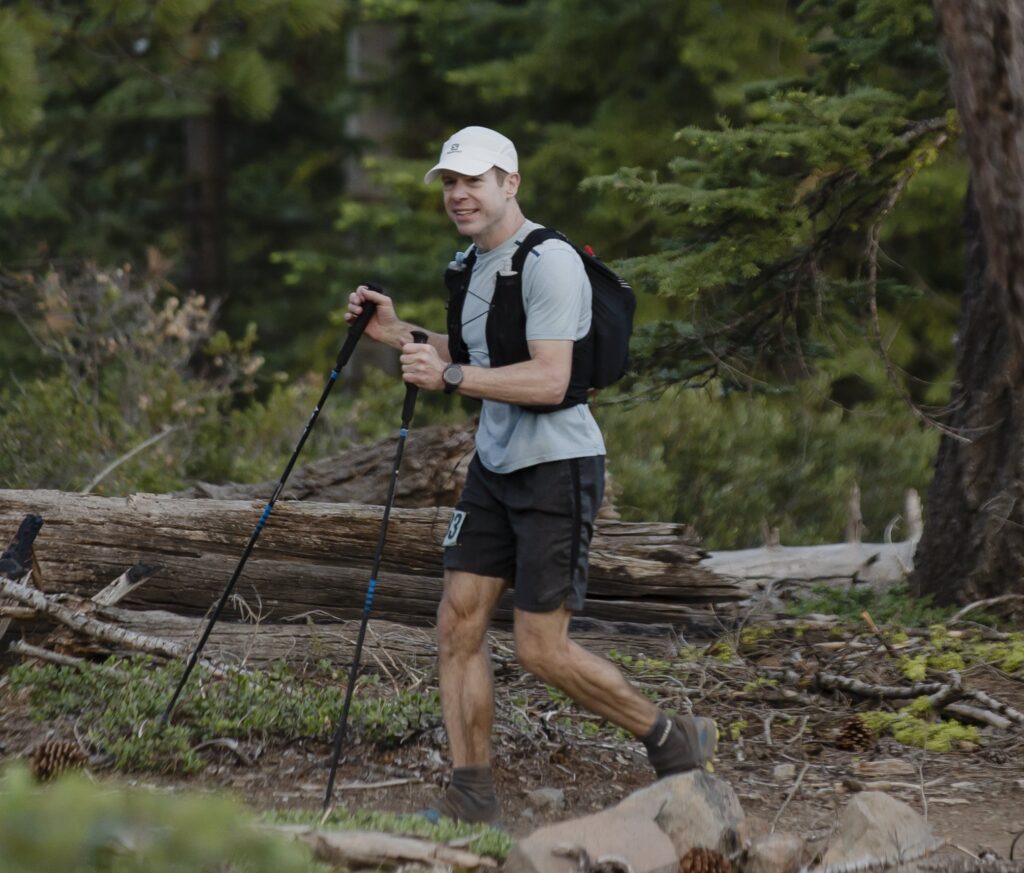
Seeing Double. Mile 65 to 66 to 65.
I arrived at Tunnel Creek aid station at midnight, and made a point of taking extra time to drink more fluids than I otherwise might have. Lori Enlow, the medical volunteer at the aid station, checked on me and helped ensure I got what I needed. Then I got up and headed into the night on the dirt road ascent that began the section to Spooner Summit.
I’d gone less than a mile from the aid station when I detected another slight urge to pee. As much as I hated to stop again so soon, I decided it was better to pee now and use it as an opportunity to gauge my hydration levels than to wait until I really needed to go. I stepped off the trail, certain I was going to see good news in the form of semi-clear urine.
Dark brown and cloudy. Darker even than at mile 51.
The terrain was moderately steep at this point, so I started hiking again. The thought of rhabdo gnawed at my mind. My level of dehydration was getting worse, not better, and I’d had several hours to show improvement. I started worrying about what might happen if I continued into this section without taking some sort of radical action to reverse the course of what might quickly become full-on rhabdo. I didn’t want to end up in the emergency room with permanent damage to my kidneys. But I had goals for this race. I wanted to finish well. I kept hiking up the hill.
There were still sixteen miles to the next aid station at Spooner Summit. If I end up in the emergency room because I ignored these obvious signs of a problem, I’ll have to declare myself the dumbest runner in the race, I thought. A race is not worth risking serious damage to my body
I hiked another fifty yards.
I have to turn around and get help.
Another hundred yards went by.
I’m being stupid, I finally decided.
I turned around and started the descent back to Tunnel Creek aid station. All I could think about was the time I was about to lose rehydrating my body, and the additional time I would lose later in the race when I inevitably needed to sleep. But I’d made a decision to fix the dehydration problem, and I wasn’t going to change my mind now.
“Is Lori Enlow available?” I called out as I walked back into Tunnel Creek aid station.
Lori quizzed me to ascertain what was going on, then sat me down on a chair, wrapped me in blankets, and prescribed four bottles of fluid, preferably with electrolytes, to be consumed within the next hour. We’d see how things were progressing once I’d finished all four bottles.
After that first hour, Lori and I played several rounds of a game called “Let’s See What Color Wes’ Pee Is After He Drinks Even More Fluids.” Lori is a very serious player of this game, I quickly learned. When, during round two, I told Lori, “It’s definitely getting clearer,” Lori informed me that my pee assessments were not to be trusted, and she made it known that she would be the only judge of pee color at the aid station.
Attempting to bribe the well-hydrated volunteers at the aid station to pee in the cup for me yielded no takers. Lori obviously had the volunteers in her thrall, thereby forcing me to keep playing the pee game.
It took a while, but my urine eventually met Lori’s exacting pee standards. With a big thanks to Lori and the other volunteers, I departed Tunnel Creek for the second time. It was now 3:30 in the morning, a full three and a half hours after I’d first arrived at the aid station.
Lori had been a tremendous help, and sent me off in significantly better shape than when I’d arrived. Her kindness and her knowledge got me through a situation that otherwise might have gone very poorly. I have always thought the medical volunteers were a top-notch team at all of the 200-milers I’d run, and this incident only served to reinforce that belief.
Here I Go Again. Mile 65 to 82.
Tunnel Creek to Spooner Summit felt like a slow section for me. I was tired, and I struggled to push myself. I wasn’t thinking clearly. My mind kept circling back to my lack of sleep, circling back to the time lost at Tunnel Creek, circling back to the belief that I wouldn’t make it through the race if I didn’t sacrifice a couple more hours for sleep at one of the upcoming aid stations. I thought about all of this in very negative terms. A big part of my negativity was probably a result of the sleep deprivation. And, as Lori later shared with me, some of my unclear thinking might have also been a byproduct of the rhabdo causing my body to downregulate neuromuscular firing to create a greater sense of fatigue as a protective measure. But in the end, I am responsible for my thoughts and I own the negativity that I allowed to overcome me.
By the time I reached Spooner Summit aid station at mile 82, I’d passed three runners who had passed me while I was recovering at Tunnel Creek. Instead of focusing on this progress, I was ready to drop from the race. I thought it was important to at least sleep before making a decision, because I thought it might improve my attitude. I borrowed some blankets from the aid station volunteers, and I walked up a little rise behind the aid station. I laid down in the dirt with the blankets wrapped around me. I knew I should never attempt to sleep during a race unless I was so tired that I was practically falling asleep while running. To attempt to sleep at any other time always resulted in failure. Although I was very tired, I was not yet to the point of being physically incapable of staying awake, so I should have known that it would have been better to wait to lie down at an aid station later in the race. Somehow that knowledge didn’t impact my decision-making process.
For almost two hours I lay on the hillside without falling asleep.
When I stood up again, I knew the race was over for me. I’d wasted another two hours and I was in no better shape for it. I informed Todd Nardi, another member of the amazing medical staff, of my decision. A few minutes later I turned in my GPS tracker and my DNF (Did Not Finish) was official.
I should have at least walked out of the aid station with enough supplies for the next section. I should have known that I likely wouldn’t have turned back once I’d left the aid station. I would have kept going. I would have finished the race. But, for a second time, I didn’t consider what I already knew.
Celebrating Success
On Sunday afternoon, more than a day after I’d dropped out of the race, I lay in bed watching the live tracker on my computer. Mike Groenewegen was closing the gap with the race leader, Haroldas Subertas. Haroldas had been in the lead from that very first ascent up the ski slope on Friday morning, but Mike was within striking distance of him. With both of them only a few miles from the finish, it was anyone’s guess which of them would finish first. I knew from the time I’d spent with Mike that he was a kind and humble person. He’d pushed so hard at both Bigfoot 200 and Moab 240 in 2021, and here he was in a solid second place with a chance at a win. To see that he was having such a tremendous and well-deserved race was nothing short of inspiring. I knew I had to be there to watch him finish.
Heather and I drove to the finish line later that day. We chatted with some runners I knew, and we waited to see whether Haroldas or Mike would crest the hill above the finish line first.
Eventually, Haroldas descended the final stretch and finished to the applause of those of us who had been waiting. Mike came into view only a couple minutes later. For a 200-mile race, this was practically a photo finish.
Watching Mike run down that hill and seeing the emotion on his face as he passed beneath the finish line arch renewed my connection to my own experiences. It wasn’t a connection to my finishes. It was a connection to the hardships and the doubt and the perseverance that led to those finishes. It reminded me of the joy to be found in the journey we call ultrarunning. The journey, not the finish.
My journey at Tahoe hadn’t been what I’d planned, but I’d had experiences that wouldn’t be forgotten, I’d run with amazing runners, I’d been supported by kind and generous people such as Heather and Lori, and I was moving forward to the next step of my adventure with a sense of joy and anticipation.
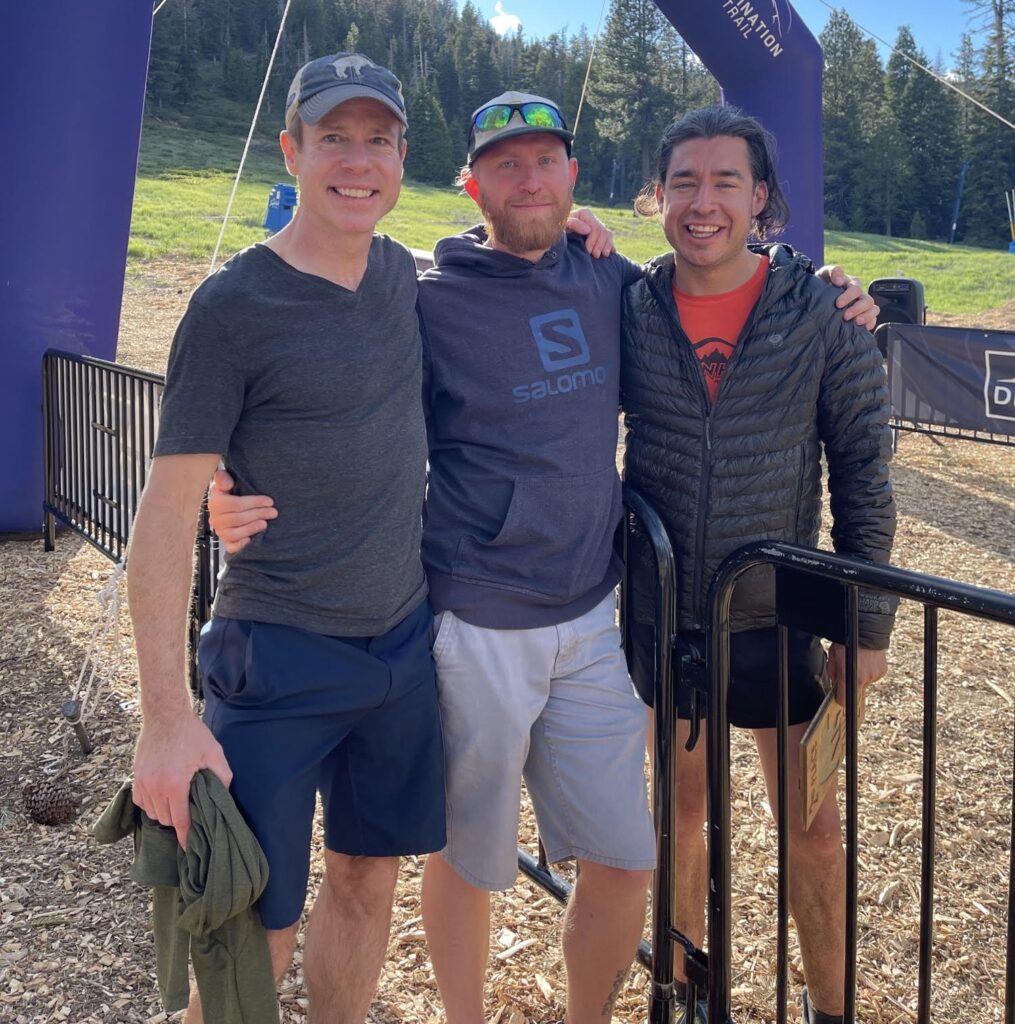
Parting Thoughts
This was my third DNF at a race.
The first DNF was in 2008 at a 10k. The race began at high noon in the blistering heat of a clear summer day in Austin, Texas. It wasn’t until a couple minutes before the start of the race that I realized I felt a bit dehydrated. But by then it was too late. At the sound of the starting gun, I surged forward with the rest of the crowd. I ran as hard as I could until I collapsed somewhere short of the finish line. I regained consciousness laying on my back on the grass beside the course. Someone from the medical staff was kneeling beside me and asked if I knew where I was. I said I was in Dallas. The medic informed me that I was in Austin. He asked if I’d finished the race. I said that I had finished. He shook his head, and then helped me onto a golf cart to be taken to the medical corral for an I.V.
My second DNF was at mile 145 of the Tahoe 200 in September of 2017. My electrolytes had been significantly out of balance for more than forty miles, I’d been repeatedly vomiting for hours, and I knew I needed to drop out of the race before something worse happened.
My first two DNF’s were caused by medical issues. My DNF at Tahoe in 2022 was not. It was a problem of spirit, a problem of will. Dehydration and sleep deprivation were medical issues, of course, but these were not what truly caused me to drop from the race. They were merely contributing factors.
Negative thoughts began when I clambered out of bed the morning of the race after seven hours of sleeplessness. This same negativity resurfaced as early as the first 20 miles when I calculated how much time I was going to lose by sleeping in the midst of the race. I always have low points in races of this length, but never have I had feelings like that so soon after starting. I should have fought the negativity, but I didn’t. It simmered in the background, and then rose to the surface intermittently throughout the race. Instead of acknowledging my low feelings and then moving forward to focus on the positive aspects of the opportunity in front of me, as I’d always done in previous races, I let that negativity guide my decisions. And, because of that, I DNF’d.
I won’t forget what happened in this race. I will remember the poor decisions I made and I will remember the good ones. I will apply what I learned. My next test will be at Bigfoot 200 eight short weeks after dropping out of Tahoe 200. I will not fail the test.
See you on the trails!
Wes Ritner
